Red light therapy can considerably boost your cellular metabolism when you follow key protocols. Target wavelengths between 630-850nm for ideal ATP production, positioning your device 6-12 inches from treatment areas for 10-20 minute sessions. You'll maximize benefits by scheduling 3-5 weekly treatments during peak activity hours, ideally pre- or post-workout. Combine sessions with protein-rich foods, HIIT exercise, quality sleep, and proper hydration to enhance metabolic function. Wear protective goggles and maintain consistent sessions while tracking your progress through measurements and energy levels. The deeper you explore these science-backed techniques, the more powerful your metabolic transformation can become.
Understanding Red Light Wavelengths
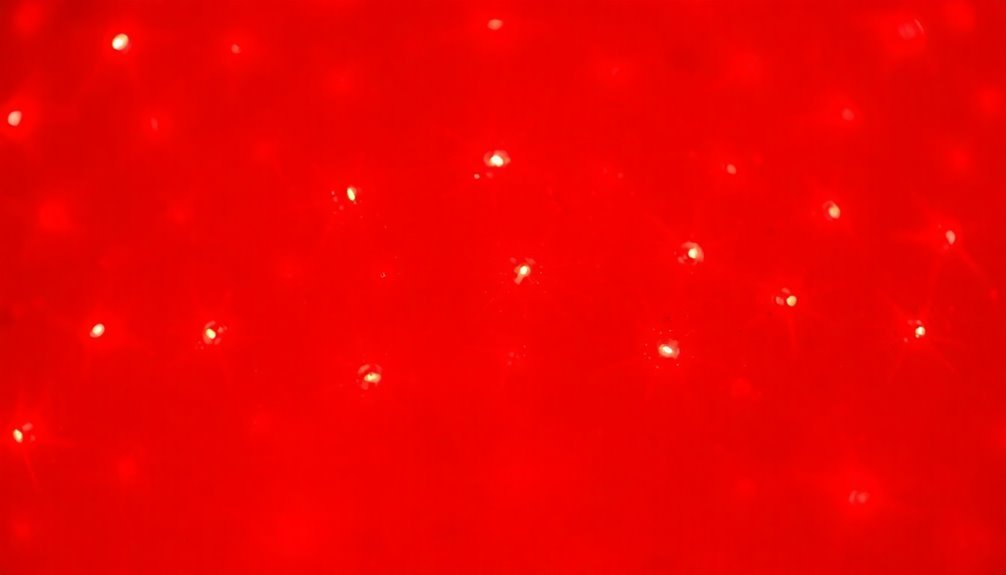
Light waves are the fundamental building blocks of red light therapy, operating within specific wavelength ranges that determine their therapeutic potential. Red light spans from 610-760 nanometers (nm), while near-infrared light extends from 760-1400 nm. Each range offers unique benefits due to its distinct penetration capabilities.
You'll find that red light can penetrate up to 2.5 centimeters into your skin tissue, while near-infrared light reaches even deeper, accessing your muscles, bones, organs, and brain tissue. The most effective therapeutic benefits occur within the 630-1000 nm range, targeting a broad spectrum of conditions from skin rejuvenation to neurodegenerative diseases.
When you're exposed to these wavelengths, they interact directly with your cells' mitochondria, specifically targeting cytochrome c oxidase. This interaction kicks off a series of biological responses that boost ATP production and reduce oxidative stress. The therapy utilizes low-power densities without generating heat during treatment.
Understanding these wavelengths is essential because they determine how deeply the light penetrates your tissue and which cellular mechanisms it activates. The precise wavelength selection in your treatment can meaningfully impact its effectiveness for specific conditions, from surface-level skin concerns to deep tissue healing.
Maximizing ATP Energy Production
You'll get the best ATP production results by targeting specific zones of your body where mitochondria are most concentrated, such as muscles and major organs.
To optimize cellular energy production, you'll want to focus on wavelengths between 630-850nm, with particular emphasis on 660nm and 850nm for deeper tissue penetration. Blood flow enhancement during treatment helps distribute nutrients more effectively to your cells.
Consistent exposure of these wavelengths to your target areas for 10-20 minutes will help maximize your mitochondrial ATP production and boost your cellular energy levels.
Targeting Mitochondrial Energy Zones
Cellular powerhouses known as mitochondria are central to releasing the full potential of red light therapy. Your mitochondria orchestrate a complex energy production system that converts nutrients into ATP through oxidative phosphorylation, yielding over 30 ATP molecules from each glucose molecule.
To maximize your therapy's effectiveness, you'll want to target areas with high mitochondrial density. These zones include metabolically active tissues where your cells are constantly engaged in energy-intensive processes. The presence of cardiolipin-rich membranes in these areas enhances the efficiency of energy production.
Your mitochondria don't just produce energy – they're also essential for calcium signaling, redox balance, and cellular survival.
When you're targeting specific body areas with red light therapy, you're supporting your mitochondria's electron transport chain, which creates the electrochemical gradient necessary for ATP production.
Your cells' energy factories respond to this light stimulus by enhancing their efficiency in converting nutrients like glucose, fatty acids, and lactate into usable energy.
Understanding these mitochondrial energy zones helps you position your red light therapy device more effectively.
You're not just illuminating tissue; you're activating cellular powerhouses that control your body's energy production, metabolic regulation, and overall cellular health.
Optimizing Light Wavelength Selection
Several critical wavelengths within the 630-850 nm spectrum release the full potential of red light therapy for ATP production.
You'll achieve ideal results by targeting specific wavelengths that penetrate different tissue depths, from surface-level skin to deep muscle and bone. Near-infrared light between 760-1400 nm reaches deeper tissues, while the 850 nm and 940 nm wavelengths prove most effective for stimulating electron transport and cytochrome c oxidase activity.
Your body responds differently to various wavelengths, with cellular chromophores interacting most effectively within the 600-850 nm range. The process directly enhances cellular energy production through improved mitochondrial function.
When you're selecting a device or treatment protocol, focus on these wavelength-specific impacts:
- 850 nm continuous light considerably boosts intact cell respiration and ATP production
- 830 nm and 940 nm pulsed light enhances your cells' resistance to external stress
- Near-infrared wavelengths (850 nm and 940 nm) enhance mitochondrial complex respiration
- Red light wavelengths separate nitric oxide from cytochrome c oxidase, maintaining ATP production
For maximum benefits, schedule 10-20 minute sessions 3-5 times weekly for 10-15 treatments, then maintain with weekly sessions.
Always wear protective eyewear during your treatments.
Optimal Treatment Zones
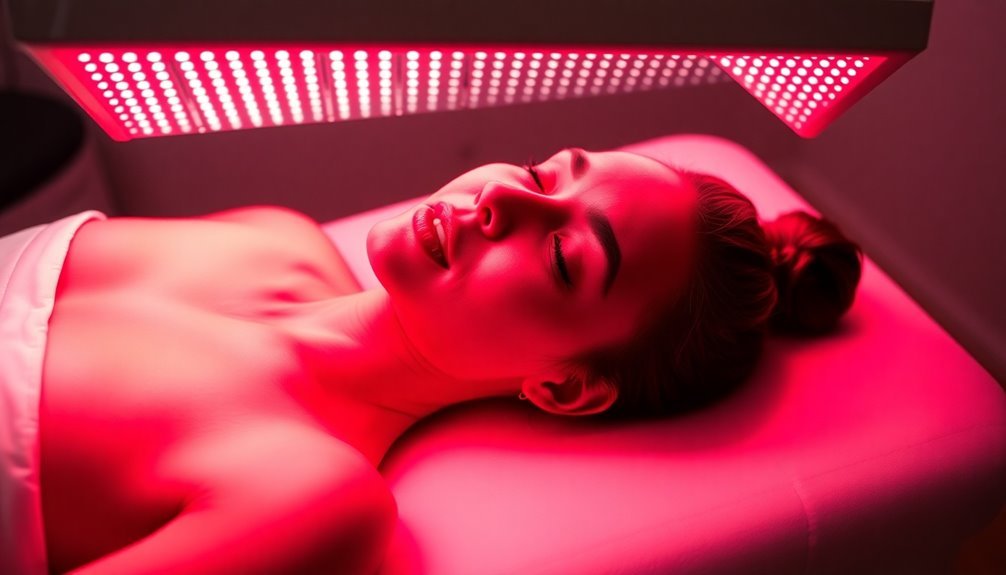
Finding the ideal treatment zones for red light therapy requires careful attention to three key factors: distance, wavelength, and exposure time. You'll achieve excellent results by positioning your device 6-12 inches from your treatment area, adjusting based on your specific goals and device specifications. Maintaining device cleanliness and performance through regular maintenance will ensure optimal light delivery to your treatment zones.
For effective treatment zones, you'll need to match the wavelength to your target area. Use 660nm wavelengths for surface-level concerns and 850nm for deeper tissue treatment. Your session duration should vary from 1-10 minutes depending on the area's depth and size.
| Treatment Area | Distance | Wavelength | Time | Power Density |
|---|---|---|---|---|
| Facial Skin | 6-8" | 660nm | 1-3 min | Higher |
| Joint Pain | 8-10" | 850nm | 5-7 min | Medium |
| Muscle Soreness | 6-8" | 850nm | 5-10 min | Medium |
| Surface Wounds | 6-8" | 660nm | 2-4 min | Higher |
| Deep Tissue | 8-12" | 850nm | 7-10 min | Lower |
Remember to start with conservative treatment times and gradually increase based on your body's response. You'll want to limit your total daily exposure across all treatment zones to 80J, adjusting your distance and time accordingly for excellent results.
Daily Protocol Guidelines
For ideal results with red light therapy, you'll want to maintain consistent treatment sessions lasting 10-20 minutes, scheduled 3-5 times per week.
Position your device at the recommended distance from your target treatment areas, typically 6-12 inches away, ensuring the light properly penetrates the tissue. Regular sessions help promote ATP production and efficiency at the cellular level.
You can maximize benefits by treating multiple zones in a single session, moving the device systematically across different body areas while maintaining the recommended exposure time for each zone.
Treatment Duration and Frequency
Red light therapy works best when you follow a structured treatment protocol that balances duration and frequency. You'll achieve superior results with 10-20 minute sessions, as longer exposure doesn't necessarily yield better outcomes.
Research shows that short-term sessions with higher power density actually outperform longer sessions with lower power density, especially when the power density exceeds 10 mW/cm². These sessions can increase ATP production by 24.5% when using red light at 660nm wavelength.
For maximum effectiveness, you'll want to maintain a consistent schedule of 3-5 sessions per week initially, followed by weekly maintenance sessions. After completing 10-15 total sessions, you'll start experiencing long-lasting benefits.
Daily use can accelerate your results, particularly when using pulsed light at frequencies between 10-100 Hz, with 40 Hz showing notable improvements in cellular metabolism.
- Keep your sessions between 10-20 minutes, with 15 minutes being ideal for specific benefits like glucose reduction.
- Start with 3-5 weekly sessions during your first month of treatment.
- Switch to weekly maintenance sessions after completing 10-15 total sessions.
- Choose pulsed light settings at lower frequencies (10-40 Hz) over continuous wave modes for enhanced therapeutic effects.
Best Device Placement Zones
Proper device placement can make or break your red light therapy results. For maximum benefits, you'll need to position your device at specific distances based on your treatment goals. When targeting anti-aging and skin health, keep the device 30-45 cm away from your body. For wound healing, hair loss, and pain management, position it closer at 15-30 cm. Initial treatments should follow a 3-5 weekly sessions schedule to establish an effective routine.
| Treatment Type | Distance | Best Placement |
|---|---|---|
| Anti-aging | 30-45 cm | Face & neck area |
| Wound healing | 15-30 cm | Directly above wound |
| Hair loss | 15-30 cm | Scalp surface |
| Joint pain | 15-30 cm | Affected joint |
| Muscle recovery | 15-30 cm | Target muscle group |
Before starting your session, verify you're wearing eye protection and your skin is clean. For targeted treatments, use smaller portable devices that you can easily position near specific problem areas like joints or facial zones. If you're using a full-body panel, place it 6-8 inches away for thorough coverage. Remember that devices with higher irradiance (over 212 mW/cm²) allow for more flexibility in placement distance while maintaining effectiveness.
Metabolism Boosting Techniques
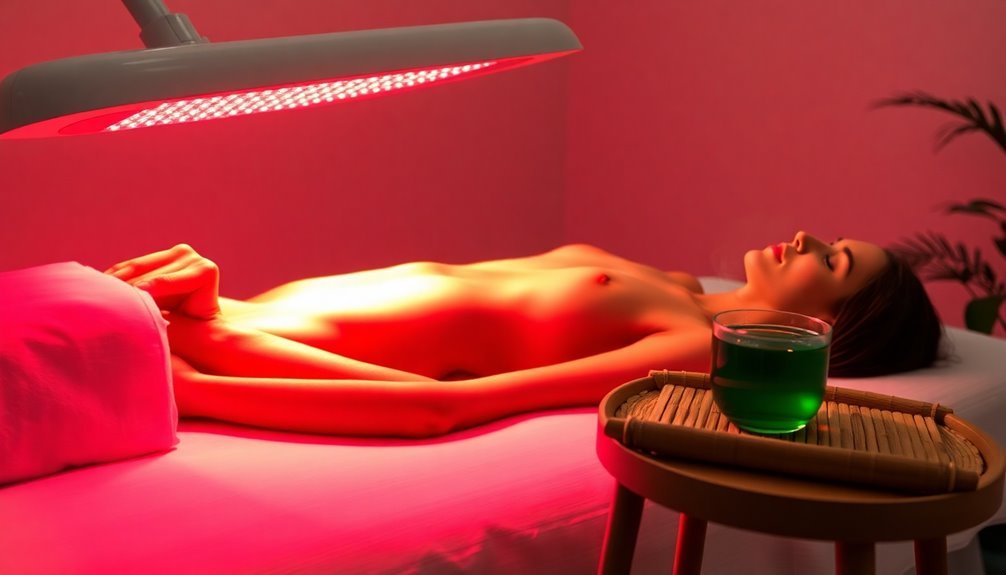
Boosting your metabolism involves four key approaches: nutritional strategies, exercise techniques, lifestyle adjustments, and supplementary habits. Each component plays an essential role in optimizing your cellular function and enhancing metabolic performance.
Start by incorporating protein-rich foods at every meal, as your body uses 20-30% of protein's energy for metabolism alone. Combine this with thermogenic foods like spicy peppers and green tea to naturally increase your metabolic rate. Understanding the balance between anabolic and catabolic processes helps optimize nutrient timing for maximum metabolic benefits.
High-intensity interval training (HIIT) and resistance training can greatly boost your resting metabolic rate by building muscle mass that burns more calories at rest.
- Prioritize sleep quality to maintain hormonal balance and support metabolic function.
- Stay hydrated by drinking at least 500mL of water to increase fat oxidation.
- Practice regular meal timing to prevent metabolic fluctuations.
- Include strength training 2-3 times weekly to enhance resting metabolism.
Fat Loss Activation Methods
You'll get the best fat-burning results by positioning red light therapy panels directly over your most stubborn fat deposits, like belly, thighs, or arms.
To boost your daily metabolic rate, schedule your sessions during peak activity hours, such as before or after workouts, when your cells are primed for enhanced energy production.
Make the most of each light exposure by maintaining a consistent 4-6 inch distance from the device and rotating your position every few minutes to guarantee even coverage of your target areas.
For optimal fat loss, exposure to wavelengths between 600 to 850 nanometers penetrates effectively into adipose tissue.
Target Stubborn Fat Areas
Targeting stubborn fat deposits requires a strategic combination of red light therapy and consistent physical activity.
You'll need to focus your treatments on specific problem areas while maintaining a caloric deficit to achieve ideal results. By combining targeted exercises with 15-20 minute red light therapy sessions, you're creating an enhanced environment for localized fat reduction.
Your body's response to red light therapy intensifies when you pair it with exercise, as the released fat cells become available for energy production. While traditional weight loss methods mightn't effectively target specific areas, red light therapy allows you to concentrate on stubborn spots like the abdomen, thighs, or arms.
- Schedule 1-4 weekly sessions targeting your problem areas
- Perform resistance training or cardiovascular exercises within 2-3 hours of treatment
- Maintain a caloric deficit to guarantee your body utilizes the released fat
- Allow 8-12 weeks of consistent treatment before expecting visible results
Remember that while red light therapy can help break down fat cells in targeted areas, you'll need to stay committed to your exercise routine and dietary plan to achieve and maintain your desired results.
Enhance Metabolic Rate Daily
Red light therapy consistently amplifies your daily metabolic rate through multiple pathways that work together. When you expose your body to red light, it triggers increased ATP production in your cells, fundamentally turbocharging your cellular energy factories. This enhanced energy production directly boosts your body's ability to burn calories and process nutrients more efficiently.
You'll activate key metabolic processes as the therapy stimulates your mitochondria and improves blood circulation. The treatment enhances lipolysis, breaking down stored fat cells while supporting your lymphatic system's ability to flush out waste products.
You're also getting better insulin sensitivity, which helps regulate blood sugar levels and improve your body's natural fat-burning capabilities.
To maximize these metabolic benefits, you'll want to incorporate regular red light therapy sessions into your daily routine. The therapy works synergistically with your diet and exercise efforts, enhancing their effectiveness through improved cellular metabolism and reduced inflammation.
Since it's non-invasive and painless, you can maintain consistent sessions without downtime, allowing your body to continuously benefit from the metabolic boost while supporting sustainable fat loss results.
Maximize Light Exposure Benefits
Building on your enhanced metabolic rate, specific positioning and timing techniques can dramatically amplify fat loss results during red light therapy sessions.
You'll want to refine your exposure to maximize ATP production and enhance the breakdown of fat cells through strategic body positioning and session timing.
Position yourself 6-12 inches from the light source to guarantee ideal cellular absorption and mitochondrial stimulation. This distance allows for deep tissue penetration while maintaining the right intensity for fat cell activation.
By targeting specific areas where fat loss is desired, you're enabling enhanced lipolysis and improved lymphatic drainage in those regions.
- Rotate your body every 5-7 minutes to guarantee even exposure and thorough fat-burning activation.
- Time your sessions for 15-20 minutes when insulin sensitivity is highest, typically in the morning or post-workout.
- Keep your skin uncovered during treatment to maximize light penetration and cellular response.
- Target larger muscle groups first to boost overall metabolic impact and hormonal refinement.
Maintain consistency with your exposure schedule, as regular sessions help sustain improved circulation, enhanced fat metabolism, and refined hormone regulation for sustained fat loss results.
Timing Your Light Sessions

When starting your red light therapy journey, understanding the ideal timing and frequency of sessions plays a crucial role in achieving desired results.
You'll want to begin with shorter 5-10 minute sessions and gradually increase to 15-20 minutes as your body adapts to the treatment.
For general wellness, schedule 3-5 sessions weekly, lasting 10-20 minutes each. If you're targeting skin rejuvenation, maintain a similar frequency.
However, pain relief might require daily sessions initially, then scaling back to 3-5 times weekly for 10-30 minutes.
Athletes should plan sessions after workouts, while those focusing on wound healing need more frequent exposure at 5-7 times weekly.
Your session duration depends on your device's intensity level. Low-intensity devices require 10-20 minutes, medium-intensity needs 5-10 minutes, and high-intensity units only need 1-5 minutes per session.
Don't overdo it – more isn't always better. Consider your condition's severity, lifestyle factors, and specific health goals when planning your schedule.
Maintain consistency in your sessions and guarantee proper positioning for ideal light absorption.
If you're unsure about timing, consult a healthcare provider for personalized guidance.
Common Treatment Mistakes
Now that you understand proper timing, let's address the common mistakes that can limit your treatment's effectiveness. Many people struggle with achieving ideal results from red light therapy due to basic errors in their approach. Using incorrect wavelengths, insufficient intensity, or inconsistent treatment schedules can greatly reduce your therapy's benefits.
The most critical mistakes you'll want to avoid fall into four main categories:
- Technical errors: Using inadequate power density, incorrect wavelengths (600-1000nm is ideal), or improper distance from the device can compromise your results.
- Timing issues: Skipping sessions, cutting treatments short, or exceeding recommended exposure times (10-20 minutes) can diminish effectiveness.
- Individual factors: Failing to account for your skin type, health conditions, or medications can lead to less than optimal outcomes or safety concerns.
- Expectation management: Relying solely on red light therapy without lifestyle changes, expecting instant results, or misunderstanding its role as a complementary treatment can lead to disappointment.
Remember that red light therapy isn't a miracle cure – it's a powerful tool that requires proper technique, consistency, and realistic expectations to achieve the best results.
Tracking Metabolic Progress
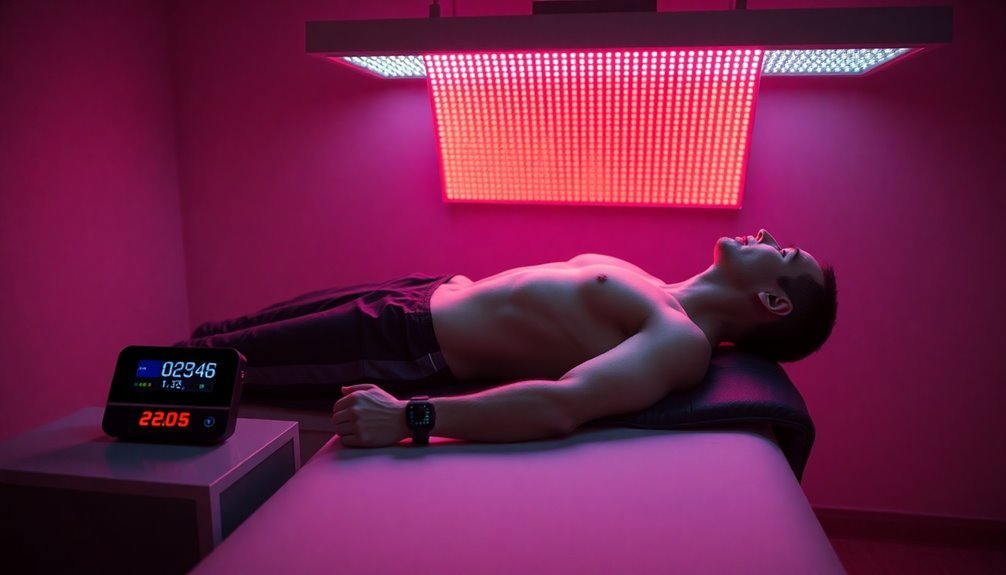
Tracking your progress throughout red light therapy helps you understand its effects on your metabolic health. By monitoring specific indicators, you'll be able to assess improvements and adjust your treatment as needed.
Start by establishing baseline measurements: your weight, body measurements, and photos to document cellulite appearance. Regular blood tests can track important metabolic markers, including glucose levels, lipid profiles, and inflammatory indicators like C-reactive protein. Keep a log of your energy levels, as improved cellular metabolism often leads to increased liveliness.
Monitor your progress using both objective and subjective measures. Document changes in your waist circumference and other body measurements weekly. Track your weight consistently, but remember that fat loss may occur even when the scale doesn't change considerably. Pay attention to how your clothes fit and any improvements in cellulite appearance.
You can also work with healthcare providers to monitor more advanced indicators. They'll help track changes in insulin sensitivity and inflammatory markers through blood tests. These measurements provide valuable insights into how red light therapy is affecting your cellular metabolism and overall metabolic health.
Safety and Best Practices
While monitoring your progress is important, understanding proper safety protocols guarantees you'll get the most benefit from red light therapy without unwanted side effects.
Though generally safe when used correctly, you'll need to take precautions to protect your eyes and skin, especially if you have a history of cancer or light sensitivity.
For ideal safety and effectiveness, you should always wear protective goggles during treatment. If you're pregnant or taking medications that increase light sensitivity, consult your healthcare provider before starting therapy.
While home devices can be effective, medical-grade treatments at a doctor's office typically deliver better results.
- Never exceed recommended treatment times – overexposure can cause skin redness and blistering
- Keep consistent with your treatment schedule – multiple sessions over weeks or months are usually necessary
- Monitor your skin's response – if you experience unusual redness or irritation, reduce exposure time
- Follow manufacturer guidelines strictly – each device has specific safety protocols
Remember that while red light therapy can effectively reduce inflammation and promote healing, it won't cause weight loss.
Your results will vary based on your specific condition and the treatment protocol you follow.
Frequently Asked Questions
Can Red Light Therapy Help With Muscle Recovery After Intense Workouts?
Yes, you'll experience faster muscle recovery with red light therapy. It reduces soreness, improves blood flow, speeds up healing of muscle tears, and enhances protein synthesis after your intense workouts.
Does Combining Red Light Therapy With Fasting Enhance Metabolic Benefits?
Yes, when you combine red light therapy with fasting, you'll enhance metabolic benefits through improved insulin sensitivity, increased ATP production, and better fat breakdown. This combination also supports cellular regeneration and detoxification.
Will Medications Affect the Effectiveness of Red Light Therapy Treatments?
Yes, certain medications can affect your red light therapy results. You'll need to check with your doctor, especially if you're taking photosensitizing drugs, as they may increase skin sensitivity or reduce treatment effectiveness.
How Long Does It Take to Notice Changes in Energy Levels?
You'll likely notice increased energy levels within 1-2 weeks of regular sessions. While some people feel energized after their first treatment, consistent use typically produces more noticeable and lasting energy improvements.
Can Red Light Therapy Help Regulate Cortisol and Other Stress Hormones?
Yes, red light therapy can help regulate your cortisol levels and stress hormones. You'll likely notice improvements in hormonal balance through its effects on mitochondrial function and cellular health during consistent treatment sessions.
In Summary
You'll get the most benefit from red light therapy by following this detailed protocol, focusing on proper wavelengths, treatment zones, and timing. Remember to track your progress, maintain consistency, and adjust your sessions based on your body's response. When you combine targeted light exposure with metabolism-boosting techniques and safety guidelines, you're setting yourself up for ideal cellular health and enhanced metabolic function.

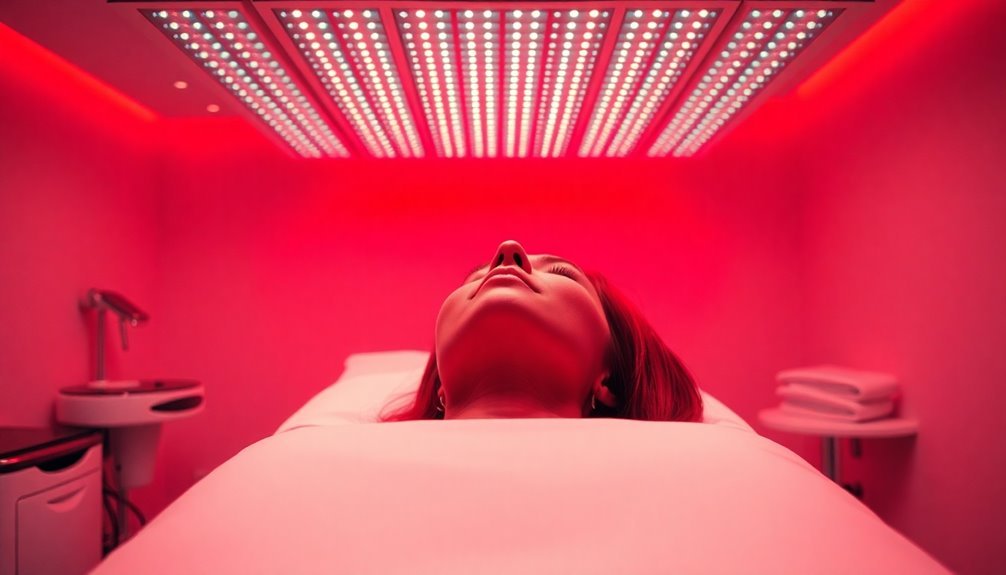



Leave a Reply